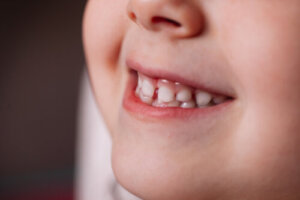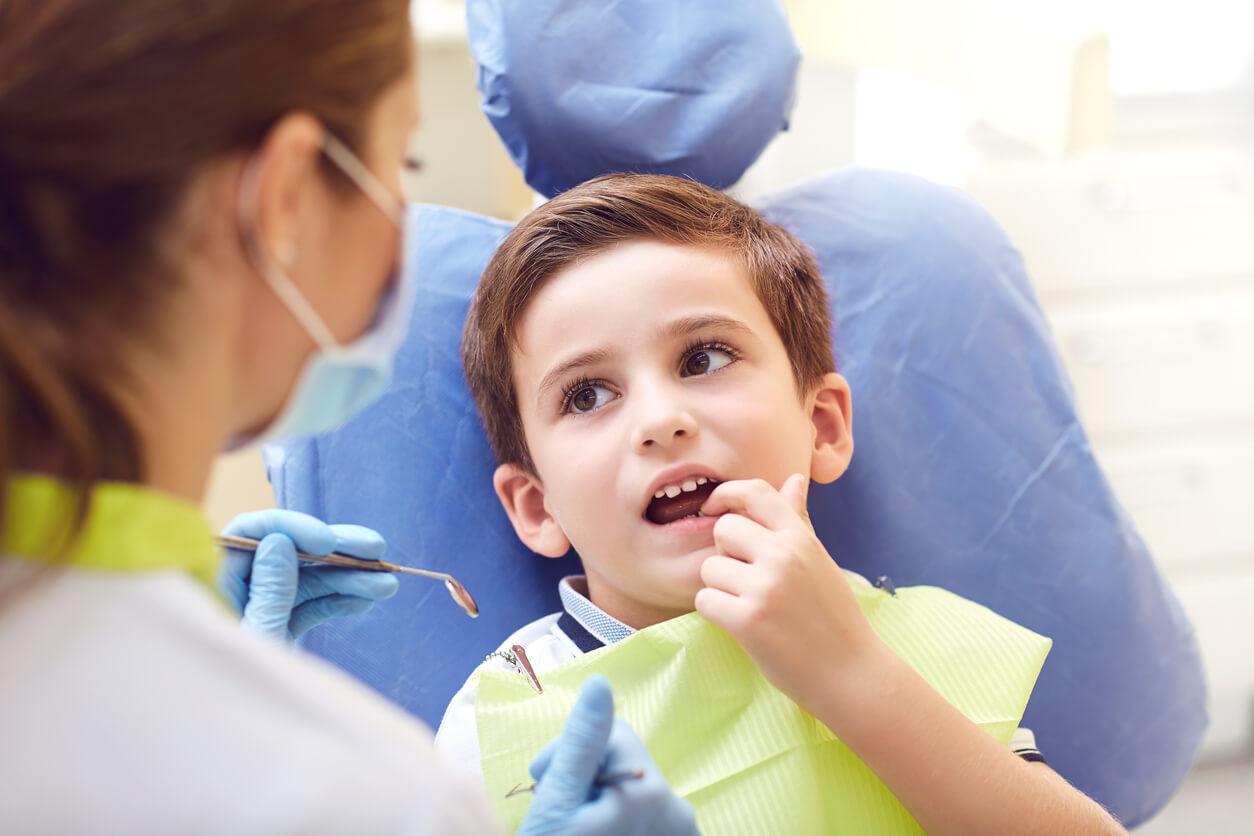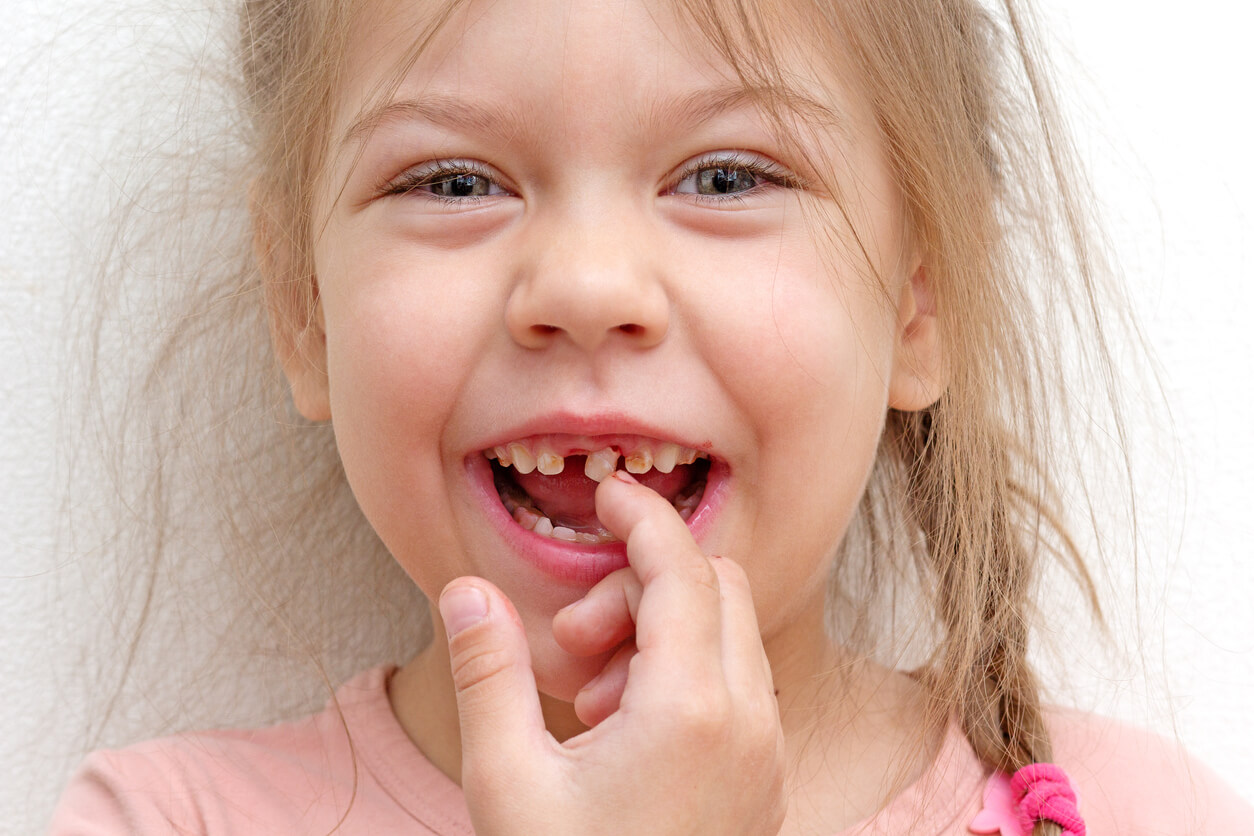What to Do if Your Child's Baby Teeth Don't Fall Out?


Written and verified by the dentist Vanesa Evangelina Buffa
It’s quite common for some parents to worry because their child’s baby teeth don’t fall out when they expect them to. They go to the dentist’s office and claim that the rest of their classmates have already lost several teeth. In this article, we’ll tell you how tooth replacement takes place and what you should do if your child’s baby teeth don’t fall out. Keep reading and find out everything you need to know.
Although the process of tooth replacement usually begins between 5 and 7 years of age, each child has their own rhythm. The early or late appearance of teeth isn’t better or worse, it’s just part of the course of development.
The process of tooth replacement
Around 6 years of age, the first baby teeth begin to fall out to be replaced by their permanent successors. The pieces are gradually molted to culminate the process around 11 or 12 years of age. The permanent elements are the ones that begin the process of tooth replacement by reabsorbing the roots of the temporary teeth inside the bone. This causes the baby teeth to begin to loosen and become increasingly loose until they fall out.
It’s important to allow the process to develop naturally, without forcing or pulling the teeth out. Sometimes it takes quite some time from the time the element starts to move until it falls off. When the temporary piece has come off, the final piece will begin to pop into the empty site to take its place. This process occurs progressively. In general, the first pieces to move are the lower central incisors.

What to do if your child’s baby teeth don’t fall out
We’ve already detailed how the physiological process of tooth replacement occurs. But it doesn’t always happen in this way, so situations may arise that worry parents.
Consult with your child’s dentist
A fairly common circumstance is the eruption of a permanent tooth without the temporary one having fallen out. In this case, the permanent tooth comes in behind the baby tooth, which often doesn’t even move. This scenario of a double row of teeth worries parents a lot, so going to the dentist is the most advisable thing to do.
In any case, it’s good to clarify that a double row of teeth isn’t a serious problem and it usually resolves by itself. Therefore, sometimes it’s advisable to wait and stimulate the fall. However, in other cases, the extraction of the baby tooth will be necessary. The definitive tooth that has already erupted, in general, relocates on its own in the place where it belongs.
Be patient and respect the natural development
Another situation that can occur is that time passes and the baby teeth don’t fall out. In these cases, the best thing to do is to calm the parents’ anxiety and let the child’s development take its course. For the baby pieces to begin to fall out, the jaws must have grown sufficiently. This way, there will be room to accommodate the new, larger permanent teeth.
If the eruption of the baby teeth was delayed when the child was an infant, you can expect the replacement to be a little slower compared to other children as well.
Sometimes the dentist takes x-rays to evaluate how the eruption process is happening inside the bone.

Why your child’s baby teeth don’t fall out
Although tooth replacement is unique and particular to each child, there are some situations that may cause the process to take longer than usual. The following are some of the factors associated with delayed tooth eruption:
- Gender: There are differences in the timing of tooth replacement between girls and boys. Girls tend to replace their teeth earlier than boys, which is associated with hormonal factors.
- Being underweight or poor nutrition.
- Growth hormone deficiency.
- Children born prematurely or with delayed development.
- Anemia.
- Chronic renal diseases.
- Having received chemotherapy treatment.
- Having received a blow or trauma to the mouth.
- Dental tumors.
- Gingival fibromatosis: The gums are larger and fibrous and prevent the normal eruption of the teeth.
- Ankylosis of baby teeth: The temporary teeth are attached to the bone and prevent the eruption of the permanent teeth.
- Agenesis of the permanent tooth: The permanent tooth doesn’t exist, so the baby tooth won’t resorb or erupt.
Visit a pediatric dentist
The first visit to a pediatric dentist should be made before the child’s first birthday. After that, check-ups should be scheduled every 6 months to observe the condition and development of the child’s mouth as it grows. At the age when most children are shedding their teeth, if your child’s baby teeth haven’t yet fallen out, it’s a good idea to talk to your dentist. Chances are that you’ll just have to wait a little longer.
If there’s an abnormal situation causing the delay, the pediatric dentist will suggest the most appropriate treatment. Relying on the professional’s advice will help you know what to do. In addition, being patient and respectful of your child’s growth rate is essential to accompany this important moment. Even if it takes a while to arrive.
It’s quite common for some parents to worry because their child’s baby teeth don’t fall out when they expect them to. They go to the dentist’s office and claim that the rest of their classmates have already lost several teeth. In this article, we’ll tell you how tooth replacement takes place and what you should do if your child’s baby teeth don’t fall out. Keep reading and find out everything you need to know.
Although the process of tooth replacement usually begins between 5 and 7 years of age, each child has their own rhythm. The early or late appearance of teeth isn’t better or worse, it’s just part of the course of development.
The process of tooth replacement
Around 6 years of age, the first baby teeth begin to fall out to be replaced by their permanent successors. The pieces are gradually molted to culminate the process around 11 or 12 years of age. The permanent elements are the ones that begin the process of tooth replacement by reabsorbing the roots of the temporary teeth inside the bone. This causes the baby teeth to begin to loosen and become increasingly loose until they fall out.
It’s important to allow the process to develop naturally, without forcing or pulling the teeth out. Sometimes it takes quite some time from the time the element starts to move until it falls off. When the temporary piece has come off, the final piece will begin to pop into the empty site to take its place. This process occurs progressively. In general, the first pieces to move are the lower central incisors.

What to do if your child’s baby teeth don’t fall out
We’ve already detailed how the physiological process of tooth replacement occurs. But it doesn’t always happen in this way, so situations may arise that worry parents.
Consult with your child’s dentist
A fairly common circumstance is the eruption of a permanent tooth without the temporary one having fallen out. In this case, the permanent tooth comes in behind the baby tooth, which often doesn’t even move. This scenario of a double row of teeth worries parents a lot, so going to the dentist is the most advisable thing to do.
In any case, it’s good to clarify that a double row of teeth isn’t a serious problem and it usually resolves by itself. Therefore, sometimes it’s advisable to wait and stimulate the fall. However, in other cases, the extraction of the baby tooth will be necessary. The definitive tooth that has already erupted, in general, relocates on its own in the place where it belongs.
Be patient and respect the natural development
Another situation that can occur is that time passes and the baby teeth don’t fall out. In these cases, the best thing to do is to calm the parents’ anxiety and let the child’s development take its course. For the baby pieces to begin to fall out, the jaws must have grown sufficiently. This way, there will be room to accommodate the new, larger permanent teeth.
If the eruption of the baby teeth was delayed when the child was an infant, you can expect the replacement to be a little slower compared to other children as well.
Sometimes the dentist takes x-rays to evaluate how the eruption process is happening inside the bone.

Why your child’s baby teeth don’t fall out
Although tooth replacement is unique and particular to each child, there are some situations that may cause the process to take longer than usual. The following are some of the factors associated with delayed tooth eruption:
- Gender: There are differences in the timing of tooth replacement between girls and boys. Girls tend to replace their teeth earlier than boys, which is associated with hormonal factors.
- Being underweight or poor nutrition.
- Growth hormone deficiency.
- Children born prematurely or with delayed development.
- Anemia.
- Chronic renal diseases.
- Having received chemotherapy treatment.
- Having received a blow or trauma to the mouth.
- Dental tumors.
- Gingival fibromatosis: The gums are larger and fibrous and prevent the normal eruption of the teeth.
- Ankylosis of baby teeth: The temporary teeth are attached to the bone and prevent the eruption of the permanent teeth.
- Agenesis of the permanent tooth: The permanent tooth doesn’t exist, so the baby tooth won’t resorb or erupt.
Visit a pediatric dentist
The first visit to a pediatric dentist should be made before the child’s first birthday. After that, check-ups should be scheduled every 6 months to observe the condition and development of the child’s mouth as it grows. At the age when most children are shedding their teeth, if your child’s baby teeth haven’t yet fallen out, it’s a good idea to talk to your dentist. Chances are that you’ll just have to wait a little longer.
If there’s an abnormal situation causing the delay, the pediatric dentist will suggest the most appropriate treatment. Relying on the professional’s advice will help you know what to do. In addition, being patient and respectful of your child’s growth rate is essential to accompany this important moment. Even if it takes a while to arrive.
All cited sources were thoroughly reviewed by our team to ensure their quality, reliability, currency, and validity. The bibliography of this article was considered reliable and of academic or scientific accuracy.
- Quijada Beza, E. M. (2014). Análisis de la cronología de erupción dentaria de las primeras molares e incisivos permanentes en niños y niñas escolares de 6 a 8 años de edad con nutrición normal y con algún grado de desnutrición del municipio de Quetzaltepeque, Chiquimula (Doctoral dissertation, Universidad de San Carlos de Guatemala).
- Beltri Orta, P., Barbería Leache, E., Costa Ferrer, F., & Mourelle Martínez, R. Diferencias sexuales en la anchura de las arcadas dentales.
- Ayala Pérez, Y., Carralero Zaldívar, L. D. L. C., & Leyva Ayala, B. D. R. (2018). La erupción dentaria y sus factores influyentes. Correo Científico Médico, 22(4), 681-694.
- Ferro, M. L., Lazo, G. E., Scazzola, M. I., Segatto, R. G., Marchioni, A. P., García, M. A., … & Lazo, M. V. (2017). Importancia del diagnóstico radiográfico como preventivo de las anomalías de erupción dentaria. In II Jornadas de Actualización en Prácticas Odontológicas Integradas (SEPOI-PPS)(La Plata, 2017).
- Mourelle, P. M. (2014). Importancia de la ortopantomografía en el diagnóstico del paciente infantil. Reduca, 6(1).
- Morón, A., Santana, Y., Pirona, M., Rivera, L., Rincón, M. C., & Pirela, A. (2006). Cronología y secuencia de erupción de dientes permanentes en escolares wayúu. parroquia idelfonso vasquez. municipio maracaibo-estado zulia. Acta Odontológica Venezolana, 44(1), 31-37.
- Jiménez, L. (2018). Estudio comparativo de las dimensiones de arcadas dentarias entre niños nacidos en condiciones de prematuridad y niños a término.
- Moncayo Mero, J. P. (2020). Manejo de la erupción dental tardía (Bachelor’s thesis, Universidad de Guayaquil. Facultad Piloto de Odontología).
- Maduro Jácome, S. G. (2021). Factores que influyen en la erupción dentaria retardada (Bachelor’s thesis, Universidad de Guayaquil. Facultad Piloto de Odontología).
- Yange Flores, K. E. (2020). Estado nutricional y erupción dentaria (Bachelor’s thesis, Universidad de Guayaquil. Facultad Piloto de Odontología).
This text is provided for informational purposes only and does not replace consultation with a professional. If in doubt, consult your specialist.








